When you think of a sloth, what words come to mind? Usually people equate sloths with being slow, laidback, and adorable. Sloths represent a natural tranquility.

Sloths are arboreal mammals; they spend most of their time hanging upside down in trees.
Whenever you come across one, it is likely either sleeping or hiding from predators. On average, sloths sleep for 15-20 hours per day.
They also have a low metabolic rate while maintaining body temperatures of 86-93 °F. One benefit of having a low metabolic rate is that sloths can survive injuries that would ordinarily kill other animals.
Although they spend most of their time in tree canopies, sloths sometimes jump into water, and for animals that are so sluggish, they swim quite well.
They feed on greens such as leaves, buds, and twigs. Being tree-dwellers and herbivores, they typically live in forests.
The nutritional value of the type of food they feed on and their metabolic rate contributes to their sluggishness. There’s little nutritional value in the diet of sloths, and sometimes, it can take up to a month to digest their food. So, their laziness might just be an adaptation.
While sloths share most of these common characteristics, there are actually multiple types of sloths. In the rest of this article will explore different sloth species.
Table of Contents
3 Types of Sloths and Where to Find Them
There are 2 main types of sloths: two-toed sloths and three-toed sloths. Distributed across these 2 types are 6 extant species of sloths. The 6 extant species of sloths are:
- Maned Sloth
- Brown-Throated Sloth
- Hoffman’s Two-Toed Sloth
- Pale-Throated Sloth
- Pygmy Three-Toed Sloth
- Linnaeus’s Two-Toed Sloth
1. Two-Toed Sloths
Two-toed sloths belong to the Choloepus genus, which contains 2 species: Linnaeus’s Two-Toed Sloth and Hoffman’s Two-Toed Sloth.
While named two-toed to differentiate them from three-toed sloths, the distinction is a misnomer. Two-toed sloths have 2 digits on their forelimbs and 3 digits on their hindlimbs. This is unlike their three-toed counterparts, which have 3 digits on each forelimb and hindlimb.
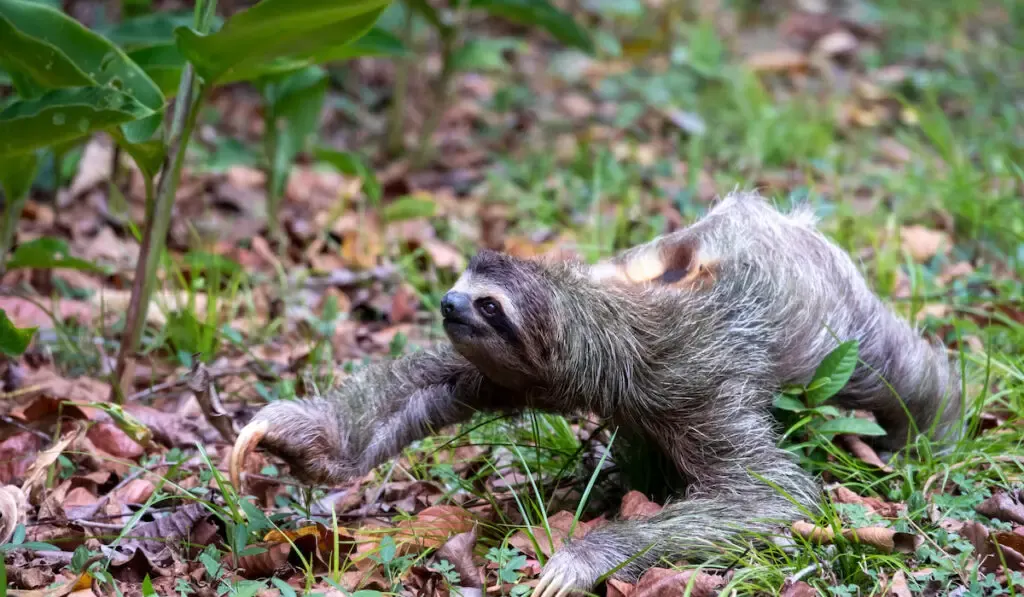
Owing to the fact that the 2 digits are on their forelimbs, two-toed sloths are more accurately described as two-fingered sloths.
Besides the differences in their digits, two-toed sloths are generally larger than three-toed sloths. On average, they weigh 8.5-20 pounds and span 21-30 inches in length.
Also, two-toed sloths have no tail, longer fur, and a relatively more prominent snout.
Both species of two-toed sloths are sometimes not easy to differentiate physically from one another. But DNA analysis help determine which is which.
Generally, sloths have a temperature range of 86-93 °F. But two-toed sloths can have lower thresholds. Their body temperature is the most variable amongst mammals. Two-toed sloths have a temperature range of 74-93 °F.
Hoffman’s Two-Toed Sloth
Hoffman’s Two-Toed Sloth is grayish brown with a brighter face. It grows as long as 21-29 inches (including the head) and weighs between 10-20 pounds.
Hoffman’s Two-Toed Sloths are found in tropical forest tree canopies in Nicaragua, Central Brazil, Peru, and northern South America.
This two-toed sloth species has a gestation period of 11-12 months, and they give birth to one offspring in a year.
Males typically mature within 4-5 years while the females mature much younger, at around 3.5 years. On average, sloths live for 15-20 years, but a lifespan of 30 years has been seen in managed conditions.
Linnaeus’s Two-Toed Sloth
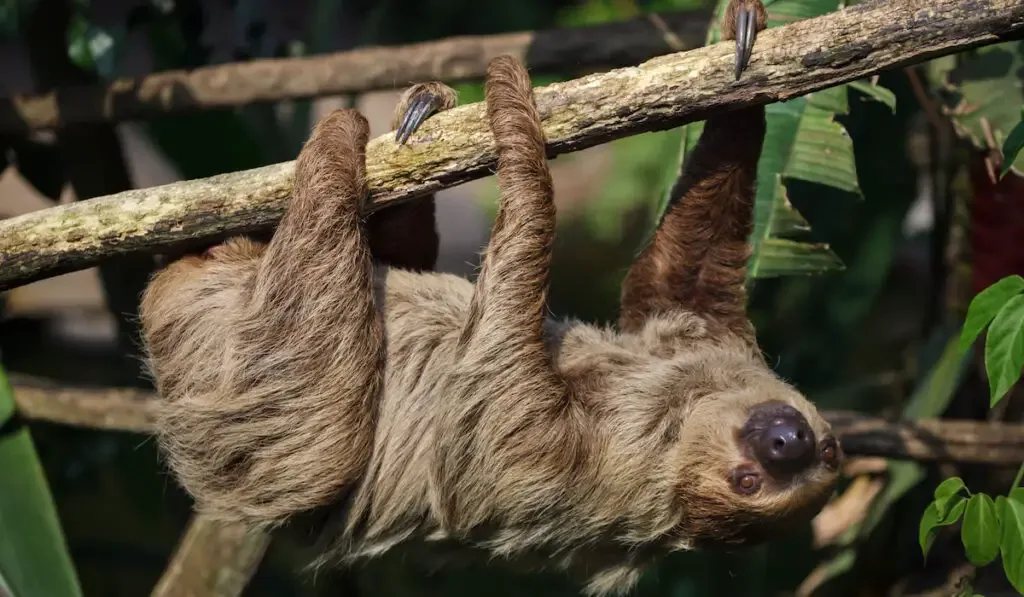
This sloth species also goes by the name Southern Two-Toed Sloth. Linnaeus’s Two-Toed Sloth typically grows as long as around 24-27 inches. They weigh an average of 9-18 pounds.
Southern Two-Toed Sloths live in tropical and subtropical forests. They can be found in Colombia, Venezuela, Peru, Ecuador, and the Atlantic coasts of northern Brazil.
Linnaeus’s Sloths have a gestation period of 9-10 months, and the offspring mature in 3-5 years. The average lifespan of this species is 20 years. However, individuals have lived 30-40 years in captivity.
2. Three-Toed Sloths
Species of three-toed sloth belong to the Bradypus genus. Members of this genus include Maned Sloth, Brown-throated Sloth, Pale-Throated Sloth, and Pygmy Three-Toed Sloth.
As you may have inferred, three-toed sloths have 3 digitations on each forelimb, unlike their two-toed counterparts, which have two.
Maned Sloth
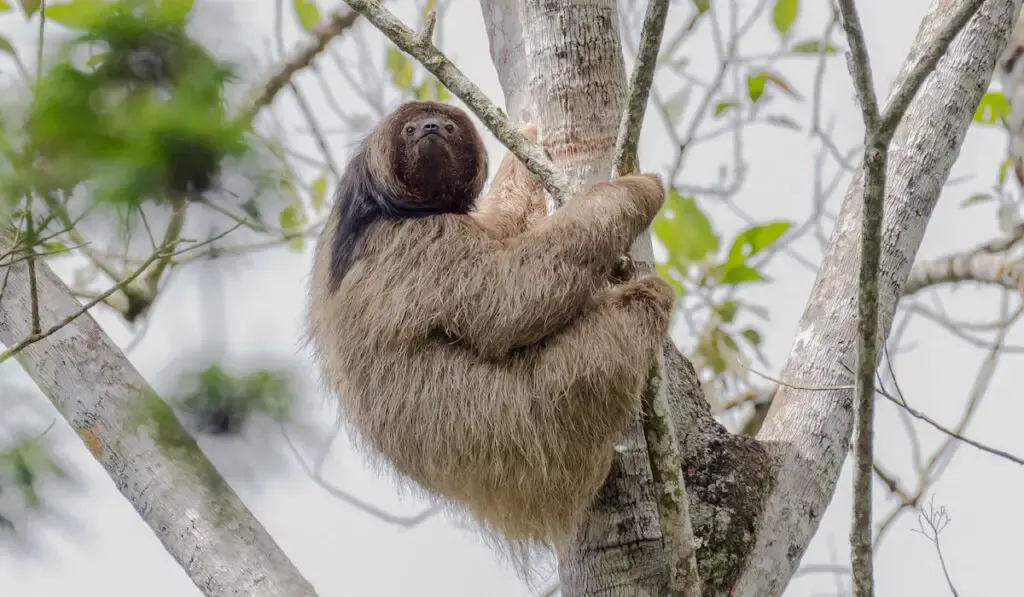
Maned sloths are mainly found around the Atlantic coasts of the Brazilian rain forest. States like Rio de Janeiro, Bahia, and Esparto Santo have some population of Maned Sloth.
Maned Sloths have heads that can rotate more than 90 degrees, their faces and chins are brown, and they can grow as long as 18-20 inches.
Although they are smaller than two-toed sloths, Maned Sloths are the largest species of three-toed sloths. Their average weight is 8-10 pounds with the females usually the larger members.
Male maned sloths are polygynous as they may mate with multiple females. Studies reveal that the larger and more powerful males are favored by the females sexually.
Female maned sloths typically reproduce in the first 6 months of the year. They gestate for 6 months and give birth to one offspring per year. Maned sloths mature within 1-3 years and live for around 20 years in the wild.
There is not sufficient information about their welfare in captivity. But it is known that they do not do well when confined. Maned sloths are currently listed as vulnerable.
Brown-Throated Sloth
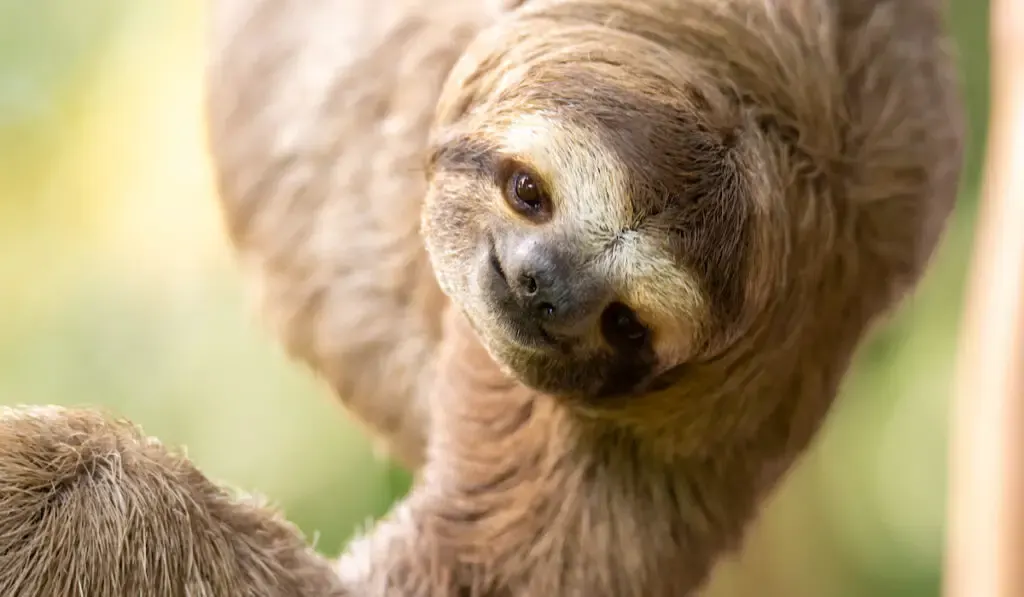
The Brown-Throated Sloth is perhaps the most common sloth species.
It is found in many Central American and South American regions including Brazil, Bolivia, Columbia, Nicaragua, Honduras, Paraguay, Panama, Peru, and Venezuela. At one point, Brown-Throated Sloths were in Argentina, but this population has gone extinct.
True to its name, this species has a head and a throat with brown coloration. However, its skin still carries a green hue from the algae in its fur, just like other sloth species.
The average body length of the Brown-Throated Sloth is around 23.62 inches, and their average weight falls between 8-11 pounds.
Brown-Throated Sloths are considered to be monogamous. The females have a gestation period of 5-8 months, and they typically give birth to one offspring per pregnancy.
Brown-Tthroated Sloths can live for up to 30-40 years in the wild. The females reach maturity around 3 years while the males reach maturity around 3-5 years.
Pale-Throated Sloth
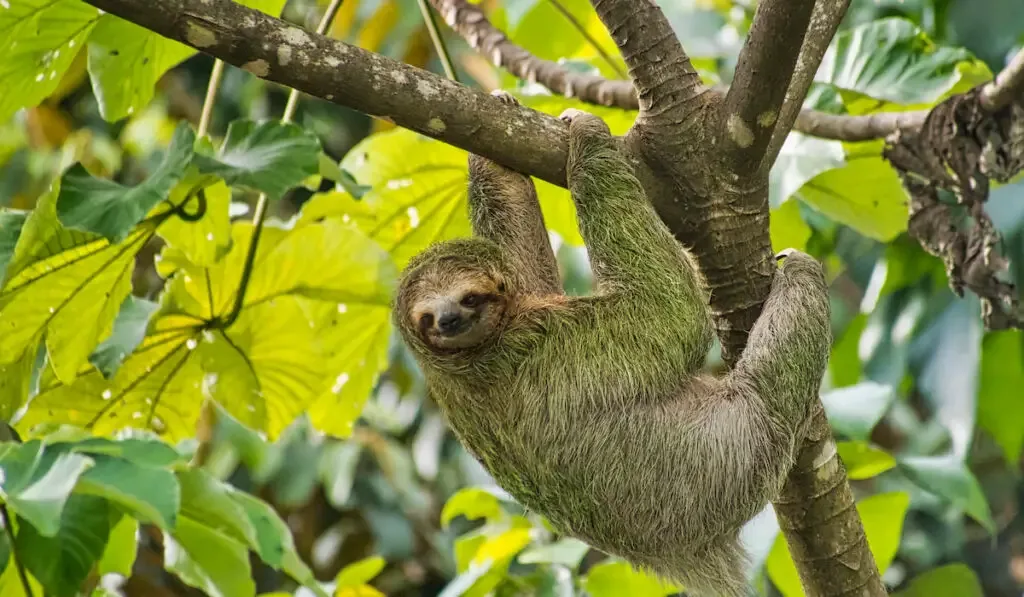
Pale-Throated Sloths are found across southern Central America all the way to northern South America. They live in the canopies of tropical rainforests.
Pale-Throated Sloths have blunt noses and slightly rounded heads. They have an average length between 18-30 inches, and they weigh between 5-12 pounds.
The gestation period for Pale-Throated Sloths is usually 5-6 months. This species usually has one offspring per year. However, unlike some other species, the males mature than the females. Female Pale-Throated Sloths take about 4.5 years to mature while the males take 3 years.
The studies on the lifespan of Pale-Throated Sloths are not thorough. Estimates predict they can live up to 40 years in the wild.
Pygmy Three-Toed Sloth
Pygmy Three-Toed Sloths are the smallest species of all sloths (both two-toed and three-toed). They are found only in Panama, particularly on the island of Escudo de Veragua. On the island, Pygmy Three-Toed Sloths stay mainly in red mangrove forests.
This species of three-toed sloth was not recognized until 2001. The Pygmy Three-Toed Sloth is critically endangered. In fact, a 2012 census revealed that there were 79 Pygmy Three-Toed Sloths left in existence. It is estimated that the current population would be less than 100.
The main threat to the population of Pygmy Sloths is the loss of habitat. The island of Escudo de Veragua is, for the most part, uninhabited. However, visits from lobster divers, fishermen, and indigenes contribute to the loss of population. Visitors are known to hunt these sloths or exploit their habitat.
Pygmy Three-Toed Sloths can grow as long as 19-21 inches while weighing 5.5-7 pounds. They feed mainly on mangrove leaves.
There seems to be limited knowledge on the lifespan and gestation period of Pygmy Three-Toed Sloths. But they bear one cub per year, and it is thought that their gestation period would be similar to other species.
3. Ground Sloths
Besides the Two-Toed and Three-Toed sloths, there is another group of sloth called Ground Sloths. There are about 80 genera of sloths spread across various families. They fall under the ground sloth group.
All Ground Sloths are extinct. However, they are genetically related to the 6 extant species of sloth, with the Two-Toed Sloth being more closely related than the Three-Toed Sloth.
While current species of sloths are arboreal, Ground Sloths were not. As the name hints, Ground Sloths mainly lived on the ground.
This predisposition to live on the ground may have been influenced by their size. Ground Sloths were much bigger than the species we are familiar with today.
The largest Ground Sloth species ever was the Megalonyx jeffersonii, named after Thomas Jefferson. Members of this species were able to attain the size of an adult ox when fully grown. They averaged 9.8 feet in length and over 2000 pounds in weight.
The evolution of Ground Sloths started in South America, but they later migrated to North America. They favored living in areas of forests around lakes or rivers.
Ground Sloths lived during the last ice age. But there is no consensus on exactly when they became extinct.
| Sloth Type | Habitat | Lifespan | Endangered Status |
| Brown-Throated Sloth | Tropical forests of various South American and Central American regions | 30-40 years in the wild | Least Concern |
| Hoffman’s Two-Toed Sloth | Tropical forest tree canopies in Nicaragua, Central Brazil, Peru, and northern South America | 15-20 in the wild Up to 30 years in captivity | Least Concern |
| Linnaeus’s Two-Toed Sloth | Tropical and subtropical forests in Colombia, Venezuela, Peru, Ecuador, and the Atlantic coasts of northern Brazil. | 20 years in the wild Up to 30-40 years in captivity | Least Concern |
| Pale-Throated Sloth | Tropical forests across southern Central America and through northern South America | 40 years in the wild | Least Concern |
| Pygmy Three-Toed Sloth | Red mangrove forests on the island of Escudo de Veragua | – | Critically Endangered |
| Maned Sloth | Atlantic coasts of the Brazilian rain forest | Around 20 years | Vulnerable |
| Ground Sloth | Forests around lakes or rivers in South America before migration to North America | – | Extinct |
Resources
- https://www.worldwildlife.org/species/sloth
- https://www.worldwildlife.org/stories/why-are-sloths-slow-and-six-other-sloth-facts
- https://animals.sandiegozoo.org/animals/two-toed-sloth#
- https://archive.org/details/encyclopediaofma00mals_0/page/776
- https://seaworld.org/animals/facts/mammals/hoffmans-two-toed-sloth/
- https://brevardzoo.org/animals/rainforest-revealed/linnaeuss-two-toed-sloth/
- https://www.worldlandtrust.org/species/mammals/linnaeuss-two-toed-sloth/
- https://animaldiversity.org/accounts/Choloepus_didactylus
- https://animaldiversity.org/accounts/Bradypus_torquatus/
- https://awionline.org/content/pygmy-three-toed-sloths
- http://www.edgeofexistence.org/species/pygmy-three-toed-sloth/
- https://www.worldlandtrust.org/species/mammals/brown-throated-three-toed-sloth/
- https://animaldiversity.org/accounts/Bradypus_variegatus/
- https://genomics.senescence.info/species/entry.php?species=Bradypus_tridactylus
- https://www.livescience.com/56762-giant-ground-sloth.html

